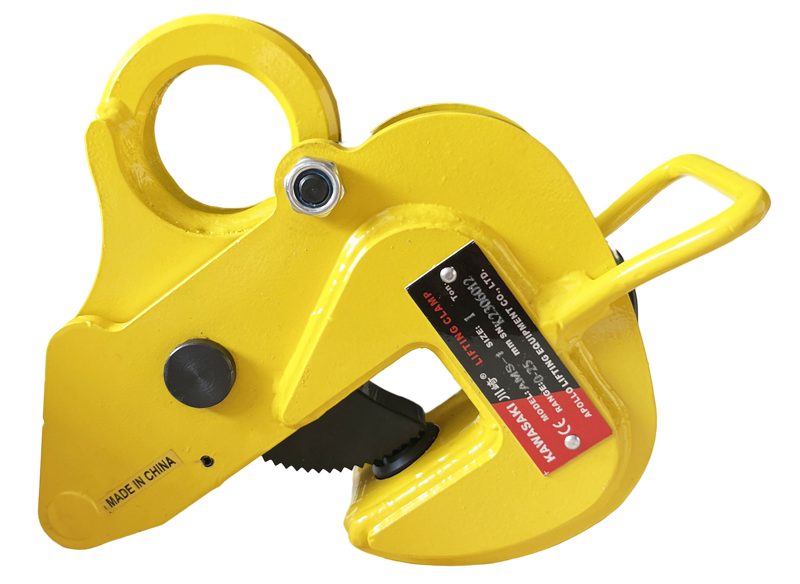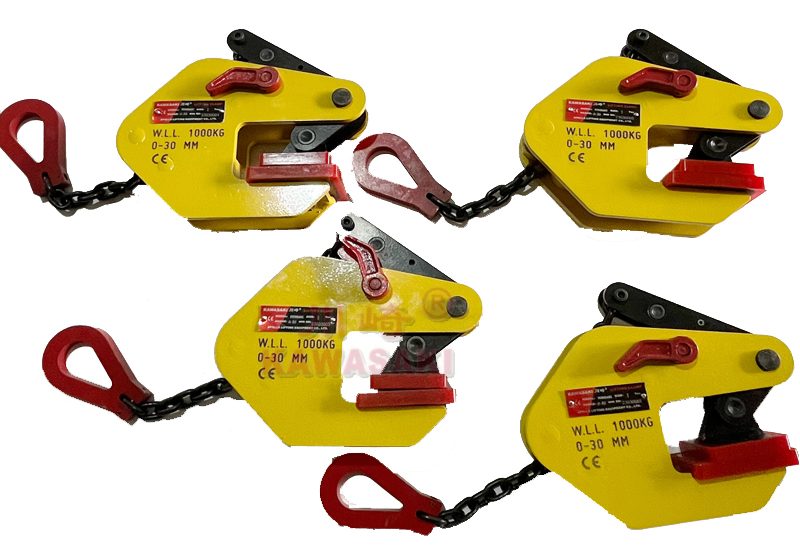Overview of Lifting Clamps
In the realm of industrial applications, lifting clamps are indispensable tools that play a critical role in ensuring efficient load handling. These devices are designed to temporarily attach to various loads, enabling the secure lifting, transportation, and placement of materials. With a wide array of applications, lifting clamps have become vital in enhancing productivity and safety across numerous industries.
Definition and Basic Functionality of Lifting Clamps

A lifting clamp is a device that grips and lifts objects, allowing for precise and secure handling. Typically, these clamps are used in conjunction with cranes, hoists, or other lifting equipment to raise heavy or awkwardly shaped items. Their primary functionality revolves around holding the load firmly to prevent slipping or dropping during the lifting process. This secure grip is crucial for maintaining the safety of both the operators and the materials being handled.
Types of Lifting Clamps
There are various types of lifting clamps, each designed to meet specific requirements based on load type, weight, and shape. Some of the most common types include:
Horizontal Lifting Clamps: These are used for lifting and transporting materials in a horizontal position. They are ideal for handling steel plates and other flat items without causing significant bending stress.
Vertical Lifting Clamps: Designed to lift loads vertically, these clamps are typically used for moving steel plates, beams, and other elongated materials. The vertical lifting clamp ensures a strong grip to prevent slippage during the lift.
Pipe Lifting Clamps: These specialized clamps are tailored for gripping and moving pipes or cylindrical objects. They secure the load evenly to prevent damage or distortion during lifting.
Sheet Lifting Clamps: Specific for handling sheets of metal or other thin materials, these clamps minimize the risk of bending or damaging the sheets while ensuring a secure lift.
Applications in Various Industries
Lifting clamps find widespread applications across different industries, showcasing their adaptability and importance in varied industrial settings.
Construction Industry
In the construction industry, lifting clamps are essential for moving large and heavy materials such as steel beams, concrete panels, and pipes. They facilitate the efficient transfer of materials to different levels of a building site, thus reducing manual labor and enhancing safety. Construction projects that involve high-rise buildings or large structural components benefit significantly from the use of lifting clamps.
Manufacturing and Fabrication
The manufacturing and fabrication sectors rely heavily on lifting clamps for handling raw materials and finished products. In these environments, lifting clamps assist in the precise positioning of components for assembly, welding, or machining. This accuracy ensures that parts are correctly aligned and assembled, contributing to the overall quality and durability of the manufactured products.
Automotive Industry
In the automotive industry, lifting clamps are used to handle various parts and assemblies during production processes. From individual components like engine blocks and chassis to larger assemblies such as entire car bodies, lifting clamps ensure that these items are moved securely and efficiently within the production line. By optimizing the transfer and placement of automotive parts, lifting clamps help maintain the flow of production and reduce downtime.
Shipping and Logistics
Lifting clamps are invaluable in the shipping and logistics sector, where they aid in the loading and unloading of cargo. They ensure the safe and efficient movement of containers, pallets, and other heavy items from trucks, ships, or storage areas. The use of lifting clamps in these operations minimizes the risk of damage to goods and enhances the speed of loading and unloading processes, thereby improving overall supply chain efficiency.
How to Choose the Right Lifting Clamp

Selecting the appropriate lifting clamp for a specific application is crucial for ensuring safety and efficiency. Several factors must be considered when choosing the right lifting clamp.
Evaluating Weight Capacity
One of the primary considerations is the weight capacity of the lifting clamp. It is essential to choose a clamp that can safely support the maximum weight of the load being handled. Overloading a clamp can lead to mechanical failure, posing a significant safety risk. Therefore, always select a clamp with a weight rating that exceeds the weight of the heaviest load intended for lifting.
Considering Material Type
The type of material being lifted also influences the choice of lifting clamp. Different materials may require different types of clamps to prevent damage or ensure a secure grip. For example, metal sheets may require sheet lifting clamps, while cylindrical objects like pipes would need pipe lifting clamps. Understanding the specific properties of the material helps in selecting a clamp that will provide optimal performance and safety.
Understanding Size and Shape Requirements
The size and shape of the load also play a crucial role in clamp selection. Some clamps are designed for flat items, while others are built to handle irregularly shaped or elongated objects. Ensuring that the clamp can accommodate the dimensions of the load is vital for achieving a secure grip and safe lifting operation. Custom or adjustable clamps may be necessary for unique or varied load shapes and sizes.
HANGZHOU APOLLO LIFTING EQUIPMENT CO., LTD.
APOLLO‘s expertise is not merely a consequence of its state-of-the-art manufacturing facilities nestled in the industrious city of Hangzhou, but also a testament to its unwavering dedication to safety, efficiency, and precision. The company’s engineers, a cadre of seasoned professionals, are artisans in their own right, sculpting robust equipment that is both resilient and reliable.
APOLLO’s commitment to innovation is evident in the ergonomic design of their clamps, which not only enhances safety but also ensures operational efficiency. The integration of advanced materials and cutting-edge technology results in a product range that consistently exceeds the expectations of the most demanding industrial scenarios.
In choosing APOLLO, industry professionals are not just selecting a lifting solution; they are embracing a partnership with a leader whose name is synonymous with excellence. APOLLO’s lifting clamps are not mere tools; they are the bearers of trust and performance in the high-stakes theatre of industrial lifting.
Safety Measures When Using Lifting Clamps
Ensuring safety in lifting operations involves more than just selecting the right clamp. Proper inspection, maintenance, and operating procedures are equally important to mitigate risks.
Proper Inspection and Maintenance
Regular inspection and maintenance of lifting clamps are critical to ensuring their reliability and safety. Before each use, clamps should be thoroughly examined for signs of wear, damage, or deformation. Any defective clamps should be repaired or replaced immediately. Additionally, routine maintenance schedules should be established to lubricate moving parts and check for proper functioning, extending the lifespan of the equipment and preventing accidents.
Safe Operating Procedures
Following safe operating procedures is imperative for minimizing risks during lifting operations. Operators must be familiar with the correct usage of lifting clamps and the equipment they are attached to. It is essential to ensure that the load is balanced and securely gripped by the clamp before lifting. Clear communication among the team members involved in the lifting process is also crucial to coordinate movements and avoid mishaps.
Training and Certification Requirements
Proper training and certification for operators handling lifting clamps are necessary to ensure a competent and safety-conscious workforce. Training programs should cover the basic principles of lifting clamp operation, safety protocols, and emergency procedures. Certification ensures that operators meet the required competency standards and are qualified to perform lifting operations safely.
Benefits of Using Lifting Clamps
The utilization of lifting clamps in industrial operations offers several advantages that enhance overall productivity and safety.
Increased Efficiency in Load Handling
Lifting clamps significantly improve the efficiency of load handling by enabling quick and secure attachment to various materials. This reduces the time spent on manual handling and allows for faster transfer and placement of loads. The streamlined operations result in increased productivity and reduced operational costs.
Enhanced Safety for Workers
By providing a secure grip on heavy or awkwardly shaped objects, lifting clamps reduce the likelihood of accidents caused by load slippage or falling. This enhanced safety is crucial for protecting workers from injuries and ensuring a safer work environment. Additionally, lifting clamps minimize the need for manual handling, reducing physical strain on workers.
Versatility in Applications
Lifting clamps are incredibly versatile, catering to diverse lifting needs across different industries. Their ability to handle various load types, sizes, and shapes makes them a valuable asset in any operation that involves material handling. Whether in construction, manufacturing, automotive, or logistics, lifting clamps prove to be a reliable and adaptable solution for many lifting challenges.
Understanding the various types and applications of lifting clamps, as well as the key considerations for selection and safety measures, can vastly improve the efficiency and safety of industrial operations. By carefully evaluating weight, material type, and size requirements, and adhering to rigorous inspection and training protocols, businesses can leverage lifting clamps’ benefits to optimize their material handling processes.



